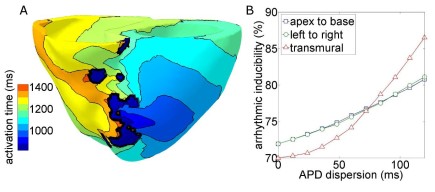Abstract
Introduction: Both electrophysiological and structural heterogeneities promote lethal ventricular tachyarrhythmias (VT) by favoring the establishment of reentry. However their relative contribution to arrhythmic risk after myocardial infarction (MI) remains unknown. Our aim is to quantify the associated risk from scar extent and repolarization gradients in the post-MI human ventricles.
Methods: In silico investigations were performed in a personalized model of the human ventricles including fiber orientation post-MI scars and human membrane dynamics. Scars consisted of a non-conductive core zone and a border zone with heterogeneous conduction velocity allowing formation of slow conductive channels. Arrhythmic risk was quantified as the percentage of VT initiations following ectopic activation in the border zone. Over 4000 scenarios comprising >2M simulations were considered by varying scar structure under different transmural apex-base and left-to-right repolarization gradients.
Results: VT was inducible in 3.27% of studied scar structures (Fig A). Successful VT initiations consistently occurred from ectopic locations close to the resulting reentrant circuit (3.65±4mm). Steep repolarization gradients increased arrhythmic risk by 15% on average with transmural gradients having the largest impact accentuating VT risk by 23% (Fig B).
Conclusions: Steep repolarization dispersion potentiates the arrhythmogenic substrate in VT-inducible scars by promoting conduction block and reentry. These results support the role of repolarization dispersion in the onset of VT and may have important implications for risk stratification of post-MI patients.


